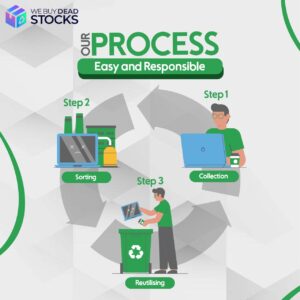Inventory is a significant asset for all businesses. So, one should understand its importance and meaning. An inventory can be all those products, materials, or goods a company holds to sell at the market for a profit. For example, a person runs a toy business; thus, all the toys he sells are the Inventory of that business. Further, Inventory can be of many types depending on the industrial need. Manufacturing industry inventory involves:
- All the products that a company is manufacturing and ready to sell.
- The raw material.
- The semi-manufactured products.
Types of Inventory
To understand further Inventory, we can discuss different types of inventories, as shown in the above image.
- Raw materials are materials that a company uses to manufacture other products. They lose their original form after manufacturing the product and are unrecognizable, e.g., oil in shampoo production.
- Components are like the raw materials used in manufacturing products. The only difference is that pieces retain their original form after manufacturing.
- Work in Progress: It involves semi-manufactured items, raw materials, labor, and packing material.
- Finished Goods: This type of Inventory involves the products that are ready to sell.
- MRO(Maintenance Repairing Operations): It is in the form of supplies that help maintain a business or support making a product.
- Packaging and Packing Materials are of three types. Primary packaging ensures product safety and usability. Secondary packaging is used to pack the finished goods involving labels. The final packaging is the bulk packaging for transport.
- Safety and Anticipation Stock: Running a business is a risky job. Minimizing the risk factor, a company buys an extra stock; a company’s additional Inventory is the safety stock. Safety stocks can cost extra, but customer satisfaction is a top priority. Similarly, anticipation stock comprises raw materials that a business buys according to market trends.
- Decoupling Inventory is the extra Inventory present at different workstations to avoid a work stoppage. Such Inventory is only preferred in manufacturing industries the most. All the other sectors prefer safety stock.
- Cycle Inventory: Companies order cycle inventory in bulk to get the perfect amount of stock for low prices. This Inventory usually includes materials that are part of some normal process or making of the products.
- Service Inventory is a management accounting concept. It determines the efficiency of service that a business can provide in a specific amount of time. For example, a hotel with ten rooms has a service inventory of 70 one-night weekly stays.
- Transit Inventory involves all the products traveling from the manufacturer to the warehouse to the customer. This Inventory is also known as the pipeline inventory.
- Theoretical Inventory: The least amount of stock a company needs to complete a process without waiting. This Inventory is primarily used in production and the food industry. It is also known as Book Inventory.
- Excessive Inventory: This type of Inventory involves the materials that a company does not expect to sell or use.
Average Inventory
Average Inventory is a calculation process used by a company to estimate how much available Inventory is over a certain period. Businesses usually count at the end of the month. Still, this number might get affected by the large unexpected end-of-month delivery stock.
Taking a mean average of stock over two or more months to get a clearer picture of how much stock will be available. The average Inventory is commonly calculated by adding the starting period inventory amount to the ending period amount and dividing the number of accounting periods.
How To Calculate Average Inventory
The Average inventory calculation formula usually does the calculation of average Inventory. The formula is:
Average inventory = (Starting inventory + Ending inventory) / Time period
In the above formula, we add starting Inventory with the ending Inventory and divide it by the tie over which you calculate the Inventory. Let’s say we want to calculate the Average Inventory for over three months; the formula will then be
Average Inventory = (Month 1 + Month 2 + Month 3) / 3.
Average Inventory Cost
The Average inventory cost is a method for calculating the price per unit of the product sold. This method is mainly used by more prominent brands with a large volume of Inventory and SKUs that are similar in cost. It helps a company calculate and track inventory value. So this method is preferable to companies over other methods. The following way calculates the average inventory cost.
Sum of cost of all stock for sale/Number Number of items sold
The above formula shows that the method works in such a way that we have to get the sum of the cost of all the products and then divide it by the number of items sold.
Days In Inventory
This term refers to the average time a company keeps its Inventory before selling it. To determine a company’s efficiency, you need to find out its days in Inventory as it shows how rapidly they sell its products. To find a company’s days in Inventory, one needs to calculate it.
The following formula can calculate the average days in Inventory of a company.
Days in Inventory = (Average Inventory / Cost of Goods Sold) x Period Length
The details required for calculating average days in Inventory are as follows;
- Period Length: This refers to the amount of time you need to calculate the days in Inventory.
- Average Inventory: The number of products a company keeps in Inventory.
- Cost of sold goods: The money gathered is further used to create more products.
Calculating Average Inventory Period
This method determines how long it will take to sell the Inventory. Calculating the average inventory period involves dividing the number of days, weeks, or months. It depends on the inventory turnover ratio frequency you wish to use.
The formula to get the equation is
Average inventory period = Time period / Inventory turnover ratio.
Ending Inventory
Ending Inventory is the value of goods still available at the end of an accounting period. Such Inventory includes the number of products the company holds for sale after the season ends. There are several ways of calculating the cost of ending Inventory. One of the methods is calculating it through the average cost method.
The number of total unsold items* Average cost per item.
The above formula shows that to calculate the average cost of ending Inventory, we need to calculate the number of total unsold items and then multiply it by the average price per item.
Inventory Turnover
Inventory turnover is a measure of how well your business is doing. If you have a high inventory turnover ratio, your business is good. It gives the impression that you can sell all your Inventory on time. If it is low, it is a concern for you, and you need to work on your inventory management.
To determine the average inventory turnover ratio, you need to divide the average Inventory by the cost of Inventory sold.
Conclusion
Properly managing Inventory can make or break a business. Business management is a big challenge. To overcome this challenge, one must have a solid and experienced business management team. It is costly, but once the business is on the right track, the cost won’t remain a problem. Nothing can stop that business from reaching heights and stunning the business market with its performance.





